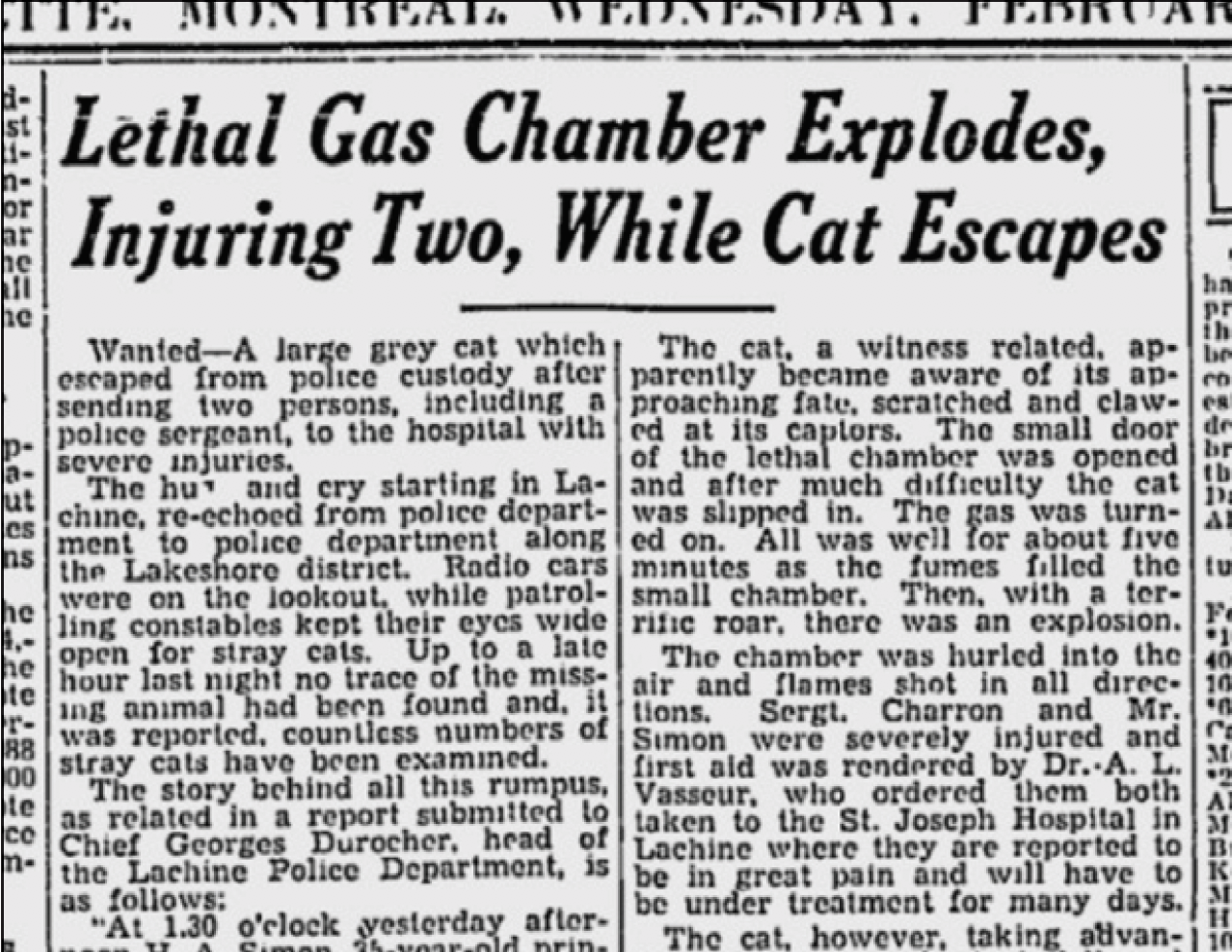A cat causes the explosion of a gas chamber for the destruction of animals (Canada, 1936)
The gas used in this case was explosive but its nature was not specified. It was very likely hydrocyanic acid, or hydrogen cyanide (HCN), the explosive component of Zyklon B (invented in the 1920s). Here the occasion presents itself for me to recall the explosive nature of that gas, sometimes used to kill pests or to execute a condemned man. In an article last year I reproduced a well-known photo from Life magazine showing an American house that had exploded during treatment with HCN.

I have in the past also spoken about the disaster caused in Croatia by a disinfestation operation in a church. I have recalled that the Degesch firm itself, in a part of the opening section of its manual for the use of Zyklon B headed Explosionsgefahr, signalled the danger of explosion. Quite recently I have unearthed a French ministerial document in which HCN is described as highly inflammable, highly explosive and highly dangerous both for the persons using it and for those nearby. One would therefore have had to be out of one’s mind to go and install, as the Germans are alleged to have done at Auschwitz-I, a homicidal gas chamber (Gaskammer) under the same roof as a cremation facility. And all the more so as there was not even a door to separate the gassing space and the cremation space, which are still visited today. Moreover, all the supposed daily gassings of hundreds of individuals purportedly took place just a few metres from an infirmary reserved for the SS (SS-Revier). With that, the infirmary would have been flooded with waves of a highly toxic gas each day at the time of the gas’s discharge. On March 19, 1976 I discovered in the archives of the Auschwitz State Museum that in reality the room dubbed “gas chamber” after the war had, during the war, been first a Leichenhalle (hall or depository for bodies) and then, after transformation works, a Luftschutzbunker für SS Revier, an air-raid shelter for the same infirmary.
The volume or density above which a gas may explode matters little. If it is qualified as explosive, that means that at any moment the volume or density in question can be reached and, thus, an explosion caused. Consequently, any flame, even that of a cigarette, must be prohibited in its presence. And that is indeed what the rules for the use of Zyklon B specify. However, in the text signed by the unfortunate former Auschwitz commandant Rudolf Höss, it is said that the Jews of the Sonderkommando or “special team”, with the job of entering the gas chamber to empty it of corpses, carried out their work “eating and smoking”. The reader will appreciate here an excellent way to gas oneself and to set off an explosion. Also according to Höss, when those men could no longer hear the cries of the victims, they would switch on the ventilation system and immediately (sofort) go into the gas chamber, eating, smoking and with the greatest unconcern! In other words, they were not even wearing gas masks. There we have a radical physical impossibility. It is true that Höss was mercilessly beaten by his captors, who then administered to him the most efficacious torture: with, for example, the point of a sergeant’s stick on his eyelids they prevented him from falling asleep for more than two days and two nights. In such circumstances anyone will end up signing any paper with any confession typed on it (Rupert Butler, Legions of Death, Hamlyn, London 1983). Finally, let us recall Höss’s conversation with Moritz von Schirmeister: “Certainly, I signed a statement that I killed two and a half million Jews. But I could just as well have said it was five million Jews. There are certain methods by which any confession can be obtained – whether it is true or not”; see note 12 to How the British obtained the confession of Rudolf Höss, commandant of Auschwitz (May 7, 1987).
Note: Wanting to limit my comments to the space of one page, I left off mentioning a supplementary example of the danger of explosion posed by HCN. This was revealed to me by staff at the Maryland penitentiary in Baltimore during my visit in 1979 to see its gas chamber (see Gas chamber of the Maryland State Penitentiary, Baltimore (USA), February 11, 1980): if the condemned man was tied so firmly to his seat, it was because of the risk that he might, while struggling in the throes of death, produce static electricity which could ignite an explosion.
March 8, 2016

